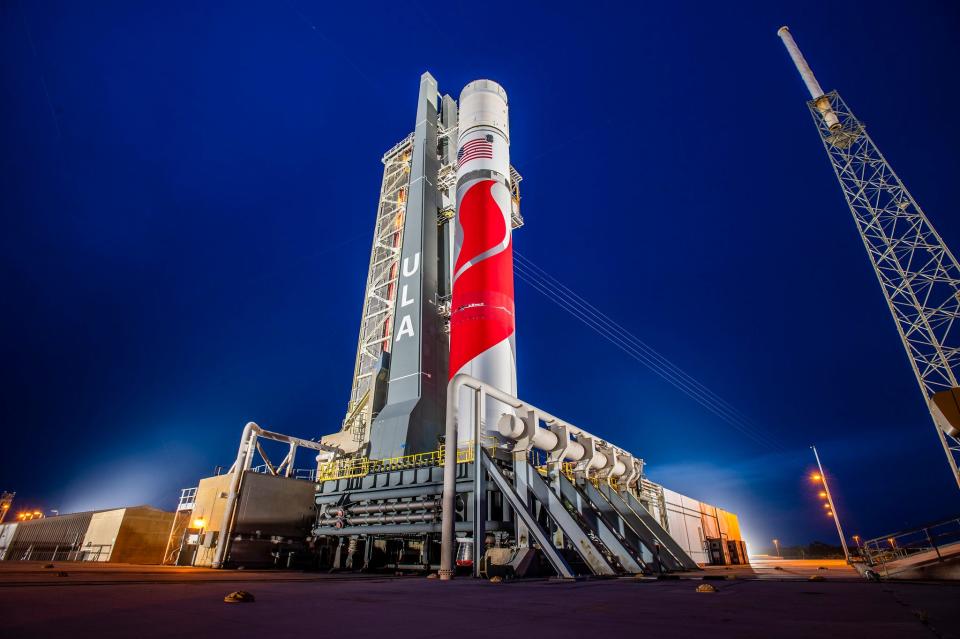United Launch Alliance achieves Vulcan rocket milestone with completed engine test fire
United Launch Alliance's new Vulcan Centaur rocket roared to life for the first time Tuesday night at Cape Canaveral Space Force Station.
In what is called a "flight readiness firing," the rocket's twin BE-4 engines, which ULA purchases from Blue Origin, ignited at 9:05 p.m. EDT and briefly fired on the launch pad of the Cape's Launch Complex 41.
While securely held in place by powerful restraining mechanisms, the test lasted a total of about six seconds, producing nearly a million pounds of thrust.
"The engine start sequence began at T-4.88 seconds, the engines throttled up to the target level for two seconds and then powered down," ULA said in a statement. "Testing is an integral part of our launch vehicle development program, and we will fly when we believe it is safe to launch."
After the test fire, the rocket will be emptied of propellants, fully secured, and returned to United Launch Alliance's Vertical Integration Facility, a short distance away from the launchpad, for pre-flight processing. Two solid rocket boosters and the debut payload will be installed on the next-generation rocket ahead of the first demonstration mission, which could happen as early as this summer.
🔥 Let's relive that beautiful #VulcanRocket Flight Readiness Firing! #CountdowntoVulcan 🔥 pic.twitter.com/WqPe3jbpiW
— ULA (@ulalaunch) June 8, 2023
"FRF is really about confirming the operational readiness of the integrated system: launch vehicle, ground systems, facilities, and the associated software," Dillon Rice, ULA's Vulcan launch conductor, said in a release.
The critical short-duration test provides much-needed performance data to help clear the path for Vulcan's inaugural launch.
Wednesday wasn't ULA's first attempt to complete the static engine test fire. A test last month was wrapped up prematurely after an hours-long countdown that was called off because of a delayed response by the booster's ignition system. Following that attempt ULA teams were required to return Vulcan to ULA's Vertical Integration Facility for troubleshooting.

Rocket launch schedule: Upcoming Florida launches and landings
Delayed indefinitely: Boeing's Starliner crewed test flight won't happen this summer because of safety concerns
Bigger, more powerful, and cheaper to produce and fly, Vulcan is designed to replace ULA’s aging Atlas V rocket and the soon-to-be-retired Delta IV Heavy rocket. It stands over 200 feet tall and can be outfitted with up to six solid rocket boosters for extra thrust.
No longer being offered for new missions, the Atlas V is expected to continue flying through the mid-to-late 2020s to fulfill its existing contracts, including those held with Boeing and NASA to fly the troubled Starliner capsule to the International Space Station.
According to ULA, Vulcan has already been commissioned to launch more than 70 missions. Thirty-eight are dedicated to launching a majority of Amazon's Project Kuiper satellite constellation, which is planned to provide worldwide satellite internet service.
Vulcan’s first mission, known as Certification-1, is a test flight to meet certification requirements to launch U.S. Space Force national security missions in the future. Although a test flight, ULA will use the opportunity to send multiple payloads to orbit and beyond.
Scheduled to fly are two prototype broadband satellites for Amazon's Project Kuiper, a payload destined for the moon, Pittsburgh-based Astrobotic's Peregrine commercial lunar lander, and a secondary payload to the surface of the moon for the Celestis Memorial Spaceflight company.
U.S. Space Force certification of ULA's Vulcan rocket relies heavily on the success of its first commercial mission. All told, ULA estimates between 20 to 30 national security missions to launch on the Vulcan over the course of its lifetime.
For the latest, visit floridatoday.com/launchschedule.
Jamie Groh is a space reporter for Florida Today. You can contact her at JGroh@floridatoday.com. Follow her on Twitter at @AlteredJamie.
This article originally appeared on Florida Today: United Launch Alliance test fires new Vulcan rocket for first time

